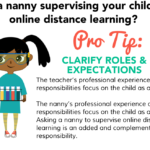
We all want our kids to be around adults who affirm who they are and help them grow with self-esteem and confidence. For families with queer parents, it’s critical to determine if a nanny candidate is LGBTQ+ affirming before inviting them to into our homes.
Many straight parents or guardians also want to make sure their childcare provider is LGBTQ+ affirming because it’s part of their core values and they recognize that gender identity and sexuality are part of a child’s development as well as that of their peers.
We want to make sure that there is alignment on many topics when hiring a nanny, but for those in the LGBTQ+ community, this ranks high on our list. We need to know that the childcare provider will support our families and our children.

How do we learn if a potential childcare provider is LGBTQ+ affirming?
Here are some ideas LGBTQ+ families shared with us. Adapt these questions and phrasing to reflect the people in your family.
1. Put it in the ad
Many families with same-sex or LGBTQ+ identified parents or children find it best to name that in any ad for childcare. The goal is to attract only candidates who embrace queer families.
Here are some examples:
“Our child has two dads.”
“This is a lesbian-parented family.”
“Must be LGBTQ affirming.”
“Experience working with LGBTQ+ families preferred”

2. Talk about it directly in the interview
Make a statement:
“I am looking for someone who is comfortable and supportive of families with two moms like ours.”
“My child is trans and does not identify with the sex they were assigned to at birth.” / “My child uses they/them pronouns.”
“As our child/ren develops, it is important to us to support them whatever their sexuality and gender identity. We want our child care provider to be supportive as well.”

3. Ask about their experience
“Have you ever provided childcare for a family before with two moms [two dads, etc]? Tell me about the experience.”
Prompt applicants to explain how they’ve handled different scenarios and how they would handle situations that might emerge.
“How would you respond to my son playing dress-up in a dress?”
“What would you do if children on the playground taunt my child for not having a dad [or mom]?”
“What’s your favorite movie/book/ kids book with a queer character or storyline?”

4. Check with references
When you speak to their references, ask them a question about how the candidate relates to LGBTQ+ people in addition to your other questions.
“Do you have a sense of if this person is LGBTQ+ affirming? Please share an example of what gives you that impression.”
A caregiver does not need to be an expert on LGBTQ+ identities in order to be a good match. In fact, during the interview, be open to answering any questions or explaining any terminology the nanny may not be familiar with. But these questions – and approaching the conversation clearly and directly – will help you explore whether they are willing to learn and whether their starting point is affirming of your child/family’s identity. The conversation should get you started on your journey to finding affirming childcare. See our other resources about how to hire a nanny including more interview questions, a sample nanny contract, and determining a fair wage.
*Many of these questions were crowd sourced from folks in the Queer Parents Facebook group. Many thanks to everyone who contributed from your personal experience.





